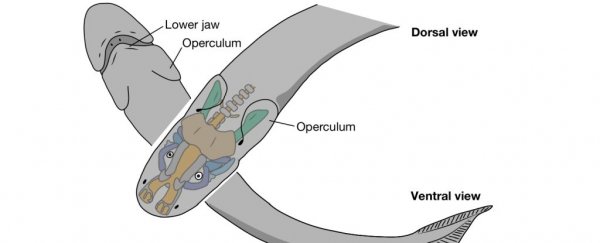A mysterious, extinct creature that has puzzled scientists for more than a century may have finally found its place in the tree of life.
The small, fish-like animal is named Palaeospondylus gunni, first discovered in fossils in Scotland in 1890, which lived approximately 390 million years ago during the Middle Devonian.
Now, according to a new analysis of well preserved fossils, scientists think that it was one of the earliest ancestors of tetrapods – animals with four limbs, including humans.
"This strange animal has baffled scientists since its discovery in 1890 as a puzzle that's been impossible to solve," says physicist Daisy (Yuzhi) Hu of the Australian National University.
"Morphological comparisons of this animal have always been extremely challenging for scientists. However, recent improvements in high-resolution 3D segmentation and visualization have made this previously impossible task possible. Finding a specimen as well preserved as the ones we used is like winning the lottery, or even better!"
There are several reasons why classifying this animal has been so problematic. Fossils of it are plentiful, but because Palaeospondylus was so small, and its fossils so damaged, reconstructing its cranial anatomy was enormously difficult.
Plus, its anatomy shares features with both jawed and jawless fish, in addition to a complete lack of teeth and dermal bones preserved in the fossil record.
The research team, led by paleontologist Tatsuya Hirasawa of the University of Tokyo and RIKEN in Japan, sought to resolve these problems by seeking out exceptional specimens, with the heads still firmly embedded, and hidden, in the rock.
This meant that the heads of the animals were likely much more intact, compared to fossils with exposed heads.
 Palaeospondylus doesn't want to hear it. (Hirasawa et al., Nature, 2022)
Palaeospondylus doesn't want to hear it. (Hirasawa et al., Nature, 2022)
"Choosing the best specimens for the micro-CT scans and carefully trimming away the rock surrounding the fossilized skull allowed us to improve the resolution of the scans," Hirasawa says.
"Although not quite cutting-edge technology, these preparations were certainly keys to our achievement."
The researchers then investigated the fossils with synchrotron radiation X-ray micro-computed tomography, which allowed them to image the fossils in exquisite resolution without destroying them, to conduct a thorough examination and reconstruction.
 The reconstructed skull of Palaeospondylus. (RIKEN)
The reconstructed skull of Palaeospondylus. (RIKEN)
Even without teeth and dermal bones, the results are pretty amazing. In the skull of Palaeospondylus, the team found three curved canals, consistent with the inner ears of jawed vertebrates.
Other features of Palaeospondylus' skull resembled the skulls of two other ancient, nearly contemporaneous fish, Eusthenopteron and Panderichthys.
Both these animals belong to the taxon of lobe-finned fishes, or Sarcopterygians. All tetrapods evolved from some Sarcopterygians; these Sarcapterygians and their tetrapod descendants are known as tetrapodomorphs. Both Eusthenopteron and Panderichthys had traits similar to those seen in tetrapodomorphs.
The lack of teeth and dermal bones on Palaeospondylus presents a problem, though. Tetrapodomorphs usually have these features, and other animals contemporaneous with our strange little fish also had them.
Palaeospondylus seems to resemble a juvenile tetrapodomorph, one that hasn't developed all its adult features. This could be explained if Palaeospondylus took a different evolutionary path, one with delayed or halted development.
Whether teeth and jaws were simply slower to develop, or were lost entirely, is unknown, but it could represent an evolutionary quirk that caused the animal to develop in other ways, the researchers say, perhaps toward the evolution of limbs.
Looking ahead, the researchers say they'll continue to investigate the strange creature, in order to more definitively confirm its position in the animal family tree.
"The strange morphology of Palaeospondylus, which is comparable to that of tetrapod larvae, is very interesting from a developmental genetic point of view," Hirasawa says.
"Taking this into consideration, we will continue to study the developmental genetics that brought about this and other morphological changes that occurred at the water-to-land transition in vertebrate history."
The research has been published in Nature.
